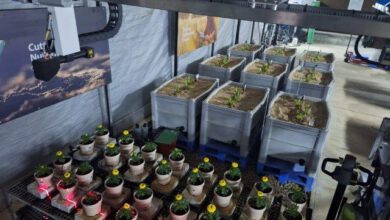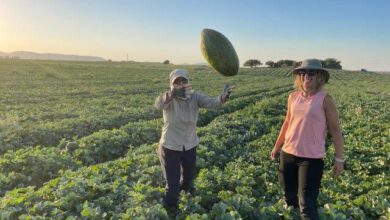Functional phenotyping: Selecting the winning crop based on its competitive performance
A simulator platform and diagnostic algorithms
Prof. Menachem Moshelion menachem.moshelion@mail.huji.ac.il

The R.H. Smith Institute of Plant Sciences and Genetics in Agriculture, The R.H. Smith Faculty of Agriculture, Food and Environment, The Hebrew University of Jerusalem, Rehovot, Israel
The development of new crop cultivars and chemical products that improve agricultural yields, in general, and under abiotic stress conditions, in particular, is a long and challenging process due to the complex nature of plant–environment interactions [known as genotype–environment (G×E) interactions]. Over the last decade, many phenotyping methods have been developed to quantify G×E interactions. However, conventional imaging-based methods are limited in their ability to produce deep understandings of the functional ramifications of these interactions. PlantDitech is an Israeli ag-tech company that has developed a simulator platform and diagnostic algorithms that allow for the production of high-resolution, whole-plant physiological profiles.
This phenotyping platform (known as PlantArray, Fig. 1) can be used to expose many plants to multiple environmental conditions (including different types of stress) in a very precise manner. The platform can be installed in many different types of growth facilities and can be used to expose plants to various and changing environmental conditions (i.e., temperature, light, humidity, soil type, soil nutrients and soil water levels). While the plants are exposed to the different conditions, the system measures the plants’ physiological parameters (e.g., biomass gain, transpiration, root flux, stomatal conductance and more) simultaneously and identifies the best-performing plants under a particular set of conditions. The entire screening/diagnostic procedure is completed within a relatively short period of time (4–6 weeks) with a high degree of accuracy. The results are highly correlated with field results, dramatically shortening the R&D process, as these trials replace and/or allow the optimization of long and expensive field trials. The platform allows new ag products (e.g.,plant-nutrition products and biostimulants, pesticides, etc.) to be brought to market more quickly and can also be used to develop optimization protocols for soil treatments,fertilizer applications and yield production under uncertain conditions, as well as for the selection of stress-resilient plants in breeding programs.
.jpg)
Figure 1.The high-throughput PlantArray screening and diagnostic platform. Deep insights into plant-environment interactions enable the selection of the right genotype or chemical treatment for improved yield and/or stress responses.
The Plant Kingdom is the primary productive biological system on Earth. In fact, photosynthetic organisms produce all of the primary organic matter on Earth (known as the five F’s: Food, Feed, Fiber, Fuel,and Fun). To grow and produce, all plants need water, nutrients, CO2 and light. To produce optimal crop yields, each genotype will have different requirements, which will be heavily dependent on the prevailing environmental conditions. Under non-optimal conditions (i.e., stress), plants shift from a productive mode of action to a defensive mode of action, with defensive activities intensifying (in a linear manner) as the stress level rises.
Genetic Applications
For centuries, breeding has led to improved crop yields. However, different crops have different environmental demands and different levels of production efficiency, which present a challenge for breeding programs and growth optimization processes. Moreover, abiotic stress (i.e., drought, salinity, temperature, etc.) is becoming an increasing concern due to climate changes and urbanization, which limit crop productivity and the availability of high-quality land. Therefore, in recent years, many ag-tech companies and academic research institutions have made significant investments in efforts to improve plant productivity under abiotic stress.
New technologies associated with molecular markers and genomic selection have contributed significantly to efforts to meet breeding challenges. Nevertheless, technical challenges of acquiring phenotypic data, in general, and under stress conditions, in particular, have created a major bottleneck known as the genotype–phenotype gap (GP gap). That is, a huge gap exists between the available genomic data and our understanding of how that data translates to phenotype and, in particular, yield. This bottleneck is mainly due to the fact that the phenotyping of plants still depends on long, expensive, size-limited and unstable field conditions. Moreover, selection for physiological performance (e.g., plant-stress research or optimization of growth conditions) is particularly complex and heavily influenced by environmental conditions. (Plant responses to the environment, in general, are very dynamic.)
Crop Protection and Growth Enhancers
The agchemical industry includes a large variety of manufacturers developing numerous products that aim to improve plant nutrition, reduce pests and diseases, improve crop vigor and stress responses (e.g.,biostimulants) and improve the physico-chemical properties of the soil (e.g., soil surfactants). The chemical industry is also faced with a bottleneck, in terms of the screening and selection of the most promising product candidates. Here, again, one of the limiting factors is the need to test the different effects of a potential product under field conditions, including its overall effect on crop yield. Determining the optimal method, rate and timing of application is another challenging task that requires large investments.
To reduce these major bottlenecks in stress-response research, the company has developed a simulation system that involves continuous monitoring of plant–environment interactions in pre-field experiments. The system takes accurate physiological measurements of well-defined key traits, provides a quantitative comparison of the plants’ responses to different treatments (e.g., drought, salinity, nutrients, biostimulants, etc.) and precisely predicts plant growth and productivity in the field. The main advantage of this functional-phenotyping system is that it reduces the size of the necessary field trials by reducing and optimizing the number of genotypes, chemicals, treatments, etc. to be evaluated in the field. Adopting this pre-field experimental approach is expected to reduce costs and time to market for new cultivars, plant-nutrition and crop-protection products.
.jpg)
Figure 2. Functional screening of pepper plants exposed to different salinity treatments. This experiment was designed to identify the plants’ salinity threshold. This knowledge will enable farmers to use the much cheaper saline water available in the Negev with a minimal yield penalty. (Photo taken by Nadav Haish at the Faculty of Agriculture of the Hebrew University of Jerusalem.)
Table 1. Advantages of the functional-phenotyping platform for characterizing plant-environment interactions.




